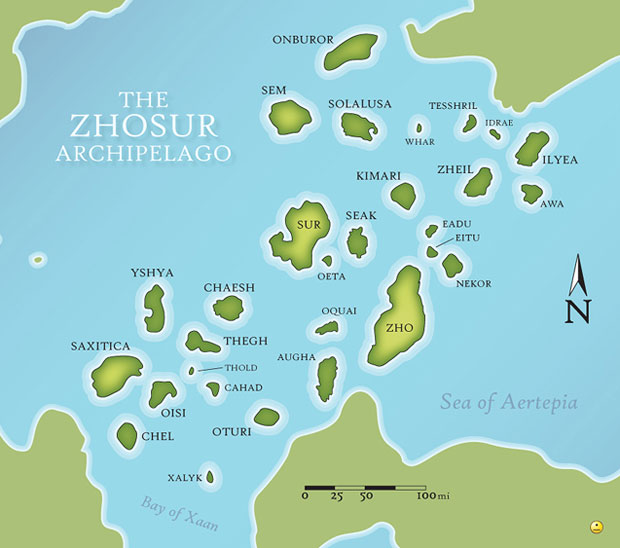Zhosur
Contents
Location and Description
The Zhosur Archipelago is a collection of islands spanning the inner sea from to the south of Thelonis to the north of Aertepia and Caulis, and is named for the two largest island kingdoms, Zho and Sur. (The area is known to the people of Molenor as Gad Ho'Kari--the "Gate of the Inner Sea.") The Archipelago is made up of roughly 29 inhabited islands, and dozens of smaller, sparsely populated or uninhabited ones. The waters of the region are rife with piracy and war.
The largest island kingdoms of the archipelago are:
- Zho (incl. Eadu, Eitu, and Nekor)
- Sur (incl. Oeta and Seak)
- Ysyha
- Saxitica
- Ilyea
- Solalusa
- Sem
- Onburor
The minor island kingdoms are autonomous to varying degrees, and alliances exist between them and/or the larger islands. The smaller islands include:
- Whar
- Tesshril
- Idrae
- Awa
- Zheil
- Kimari
- Oquai
- Chaesh
- Thegh
- Thold
- Cahad
- Oisi
- Chel
Many of the people of the islands of Oturi and Augha consider themselves a part of Greater Aertepia (Lutia, specifically), but some think the islands are--or should be--sovereign. In either case, Lutia does maintain outposts on both islands. Xalyk is little more than a trading outpost for Kalrax.
The kingdoms of Zho and Sur are the dominant forces in the region, and the two island nations are in a state of constant conflict. Each believes that the other is the only thing preventing them from total control of the archipelago. There exist several other alliances between the smaller islands, who (for the most part) wait to see whether Zho or Sur will emerge as the victor in their struggle.
Political Alliances in the Zhosur Archipelago
Dozens of smaller islands are scattered throughout the archipelago; some are sparsely populated fishing villages, but most are barely more than rocky outcroppings. Some are places of legend, home to monstrous creatures or great treasure. Notable smaller islands include Etasi, Sayh, Crol, Sheur, Atasa, Zhaim, H'Sulit, Itori, Iona, Rast, Saydan, Verem, Unan, and Ondan.
People and Culture
The people of the region are known collectively as Zhosuran, though the inhabitants of each island consider it bad manners (and, in some cases, insulting) to refer to them as such. They are more properly called by their individual cultural names: Zhotian, Surese, Solalusan, Ilyean, Semmar, Saxitican, Yshyi'i, Chelese, etc. They are--by and large-- small and slender. Men average 5'5" and women average 5'2". Skin color runs the gamut from pale in the north, to olive and light brown in the south. Hair is generally curly and dark brown or black. Eyes are olive-shaped and predominantly brown and green, and noses are typically wide and flat.
Zhosurans are masters of the sea, and are--without a doubt--the finest sailors in the known world. They are known for their curiousity and ingenuity, and many explorers of legend were Zhosuran. Piracy and constant war between Zho and Sur have made many in the region distrustful and quick to fight. Zhosurans are not unfriendly, but they value honesty and plain speaking; because of this, many inhabitants of the surrounding regions find them to be brusque and rude.
Hair Styles
Both men and women of Zhosur take great pride in their appearance. Dirty clothes, unkempt hair, etc. are considered shameful. Men of Zhosur keep their hair short and neatly trimmed. They also prefer to grow beards out once they are married. Women wear their hair long and in simple braids, or covered with colorful head scarves known as jisani.
Language
Each island in the region has its own distinct language. However, the sailors of the region have developed a pidgin language--Zosu--over the centuries, and this is known on virtually all the islands (even by non-sailors). Sailors and traders on the larger islands are often able to speak and/or understand most of the major languages of the mainland (Sarmanian, Aertepian, Caulisian, Molenorian, etc.) as well as Ilkaran.
Sports and Leisure
Not surprisingly, many Zhosuran sports are water-related, such as boat racing, swimming, and diving. Most Zhosurans (men and women) learn to swim at a very early age, and enjoy being in and around the water. They are a competitive people by nature, and like to engage in one-upmanship at every opportunity.
Zhosurans are excellent musicians and storytellers, and community life often revolves around music and dancing and the telling of myths and tall tales. Communities and extended families often gather once or twice a month for a large meal, and the revels extend late into the night.
Men known as Seyalu (literally, "traveling singers") sail from island to island, telling tales and singing traditional songs of the heroes and legends of Zhosur and the wider world. These men are highly respected and it is considered an honor to host one in a village for a week or more. Seyalu rarely get rich, as they are often paid only with food and a bed for the length of their stay, but--given the right mix of talent and charisma--Seyalu may become famous throughout the islands and perhaps as far away as the mainland.
Since Zhosuran sailors are so widely traveled, they have brought games such as Camtusa and Yre (from Ilkara), or rukh (from Caulis) back to the islands, though the names and rules of such games may be altered slightly from island to island.
Domesticated Crops
Hazel nuts, Dates, Turnips, Apples, Lime, Carrots.
Common Herbs and Spices
Oregano, cloves, and coriander.
Domesticated animals
Oxen, Sheep, Goat, Dog, Cat, Duck
Naming conventions
Zhosurans tend to eschew family names, and often refer to individuals by their given name and place of birth (e.g. [Name] of [Island] : Xartiles of Kimari or Phoalusa of Zheil).
Male names often end in: eus, os, ian, oran, les, ion, eas.
Female names often end in: ius, osa, inna, lessa, usa, ona, issa.
Creator/s: count zero
